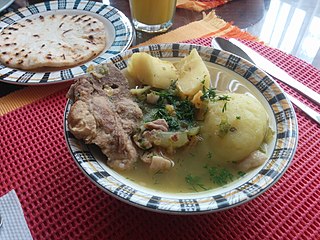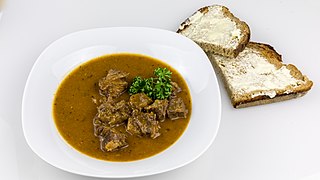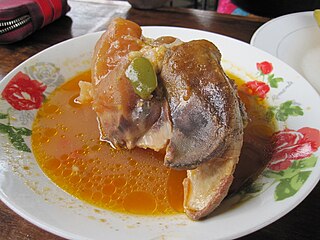
Turkish cuisine is the cuisine of Turkey and the Turkish diaspora. Although the cuisine took its current rich form after numerous cultural interactions throughout centuries, it should not be confused with other cuisines such as Ottoman cuisine or Seljuk cuisine. Turkish cuisine with traditional Turkic elements such as yogurt, ayran, kaymak, exerts and gains influences to and from Mediterranean, Balkan, Middle Eastern, Central Asian and Eastern European cuisines.

Tripe is a type of edible lining from the stomachs of various farm animals. Most tripe is from cattle, pigs and sheep.

Goulash is a soup or stew of meat and vegetables seasoned with paprika and other spices. Originating in Hungary, goulash is a common meal predominantly eaten in Central Europe but also in other parts of Europe. It is one of the national dishes of Hungary and a symbol of the country.

Offal, also called variety meats, pluck or organ meats, is the internal organs of a butchered animal. The word does not refer to a particular list of edible organs, and these lists of organs vary with culture and region, but usually exclude skeletal muscle. Offal may also refer to the by-products of milled grains, such as corn or wheat.

Pakistani cuisine can be characterized as a blend of regional cooking styles and flavours from across South, Central and Western Asia. Pakistani cuisine is influenced by Persian, Indian, and Arab cuisine. The cuisine of Pakistan also maintains certain Mughal influences within its recipes and cooking techniques. Pakistan's ethnic and cultural diversity, diverse climates, geographical environments, and availability of different produce lead to diverse regional cuisines.

Malay cuisine is the traditional food of the ethnic Malays of Southeast Asia, residing in modern-day Malaysia, Indonesia, Singapore, Brunei, Southern Thailand and the Philippines as well as Cocos Islands, Christmas Island, Sri Lanka and South Africa.

Peasant foods are dishes eaten by peasants, made from accessible and inexpensive ingredients.

Sancocho is a traditional stew in Canarian cuisine and several Latin American cuisines. Latin variations represent popular national dishes in Dominican Republic, Colombia, Cuba, Honduras, Mexico, Ecuador, Panama, Puerto Rico, Trinidad and Tobago, and Venezuela. It usually consists of large pieces of meat, tubers and vegetables served in a broth.

Kare-kare is a Philippine stew that features a thick savory peanut sauce. It is generally made from a base of stewed oxtail, beef tripe, pork hocks, calves' feet, pig's feet or trotters, various cuts of pork, beef stew meat, and occasionally offal. Vegetables, such as eggplant, Chinese cabbage, or other greens, daikon, green beans, okra, and asparagus beans, are added. The stew is flavored with ground roasted peanuts or peanut butter, onions, and garlic. It is colored with annatto and can be thickened with toasted or plain ground rice. Variations of kare-kare can be made with seafood, such as prawns, squid, and mussels, or exclusively from vegetables.

The cuisine of the Democratic Republic of the Congo and the Republic of the Congo varies widely, representing the food of indigenous people. Cassava, fufu, rice, plantain and potatoes are generally the staple foods eaten with other side dishes.

Ghanaian cuisine refers to the meals of the Ghanaian people. The main dishes of Ghana are centered around starchy staple foods, accompanied by either sauce or soup as well as a source of protein. The primary ingredients for the vast majority of soups and stews are tomatoes, hot peppers, and onions. As a result of these main ingredients, most Ghanaian soups and stews appear red or orange.

Somali cuisine was influenced by many different countries mainly due to trade, but traditionally also varies from region to region due to the expansive landmass Somalis inhabit. It is the product of Somalia's tradition of trade and commerce. Some notable Somali specialties include kimis / sabaayad, canjeero / laxoox, xalwo (halwa), sambuusa (samosa), bariis iskukaris, and muqmad / oodkac.

Oxtail soup is a soup made with beef tails. The use of the word "ox" in this context is a legacy of nomenclature; no specialized stock of beef animals are used and tails may come from bovines other than oxen. Different versions of oxtail soup exist: an ethnic dish of the American South which traces its lineage back to the pre-revolutionary war era; Korean; Chinese; a fried/barbecued oxtail combined with soup variation which is a popular dish in Indonesia where it is called as sop buntut; and a thick, rich, gravy-like soup popular in the United Kingdom since the 18th century. Creole oxtail soup is made from a tomato base with oxtails, potatoes, green beans, corn, mirepoix, garlic, and herbs and spices.

Nigerian cuisine consists of dishes or food items from the hundreds of Native African ethnic groups that comprises Nigeria. Like other West African cuisines, it uses spices and herbs with palm oil or groundnut oil to create deeply flavored sauces and soups.

Javanese cuisine is the cuisine of Javanese people, a major ethnic group in Indonesia, more precisely the province of Central Java, Yogyakarta and East Java.

A stew is a combination of solid food ingredients that have been cooked in liquid and served in the resultant gravy. Ingredients can include any combination of vegetables and may include meat, especially tougher meats suitable for slow-cooking, such as beef, pork, venison, rabbit, lamb, poultry, sausages, and seafood. While water can be used as the stew-cooking liquid, stock is also common. A small amount of red wine or other alcohol is sometimes added for flavour. Seasonings and flavourings may also be added. Stews are typically cooked at a relatively low temperature, allowing flavours to mingle.

Cow's trotters are the feet of cattle. The cuts are used in various dishes around the world, especially in Asian, African, French, and the Caribbean cuisine. Latin American cuisine also uses cow's trotters for several traditional dishes.


















